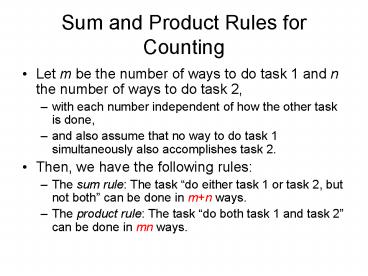Sum and Product Rules for Counting - PowerPoint PPT Presentation
1 / 6
Title:
Sum and Product Rules for Counting
Description:
Let m be the number of ways to do task 1 and n the number of ways to ... Pigeon Hole Principle. Pigeon Hole Principle: ... Generalized Pigeon Hole Principle: ... – PowerPoint PPT presentation
Number of Views:74
Avg rating:3.0/5.0
Title: Sum and Product Rules for Counting
1
Sum and Product Rules for Counting
- Let m be the number of ways to do task 1 and n
the number of ways to do task 2, - with each number independent of how the other
task is done, - and also assume that no way to do task 1
simultaneously also accomplishes task 2. - Then, we have the following rules
- The sum rule The task do either task 1 or task
2, but not both can be done in mn ways. - The product rule The task do both task 1 and
task 2 can be done in mn ways.
2
Number of Internet Addresses
- Some facts about the Internet Protocol, version
4 - Valid computer addresses are in one of 3 types
- A class A IP address contains a 7-bit netid --
not all 1s, and a 24-bit hostid - A class B address has a 14-bit netid and a 16-bit
hostid. - A class C addr. has 21-bit netid and an 8-bit
hostid. - The 3 classes have distinct headers (0, 10,
110,respectively) - Hostids that are all 0s or all 1s are not
allowed. - How many valid IPv4 computer addresses for class
A, B, C are there?
3
Principle of Inclusion-Exclusion
- If A and B are sets, then A?BA?B?A?B.
- If A and B are disjoint, this simplifies to
AB. - ( Since A?B , the empty set )
- Example Number of possible passwords with these
rules - Passwords must be 2 characters long.
- Each password must be a letter a-z, a digit 0-9,
or one of the 10 punctuation characters
!_at_(). - Each password must contain at least 1 digit or
punctuation character.
4
Pigeon Hole Principle
- Pigeon Hole Principle
- If at least k1 objects are assigned to k places,
then at least 1 place must be assigned at least 2
objects. - Generalized Pigeon Hole Principle
- If N objects are assigned to k places, then at
least one place must be assigned at least ?N/k?
objects. - E.g., there are N250 freshmen. There are k15
sections of Core I. - Therefore, there must be at least section with at
least - ?250/15? ?16.67? 17 students in the section.
5
Permutations
- A permutation of a set S of objects is a sequence
that contains each object in S exactly once. - An ordered arrangement of r distinct elements of
S is called an r-permutation of S. - The number of r-permutations of a set with nS
elements is P(n,r) n(n-1)(n-r1) n!/(n-r)! - Example How many ways can we pick 1st, 2nd, and
3rd place winners from 15 participants in the SJC
Little 500 race? (Order does matter.)
6
Combinations
- An r-combination of elements of a set S is simply
a subset T?S with r members, Tr. - The number of r-combinations of a set with nS
elements is - How many distinct 7-card hands can be drawn from
a standard 52-card deck? - The order of cards in a hand doesnt matter.































